 Backend Development
Backend Development Python Tutorial
Python Tutorial Detailed explanation of page exception handling and retry function in Python implementation of headless browser collection application
Detailed explanation of page exception handling and retry function in Python implementation of headless browser collection application
Detailed explanation of page exception handling and retry function in Python implementation of headless browser collection application
Introduction:
In web crawlers, use headless browsers Data collection has become a very common way. Headless browsers can simulate real browser behavior, can parse content generated by JavaScript, and also provide more network request control and page processing functions. However, due to the complexity of the network environment, we may encounter various exceptions when collecting pages, which requires us to handle the exceptions and design a retry mechanism to ensure the integrity and accuracy of the data.
Text:
In Python, we can use the Selenium library to work with headless browsers such as Headless Chrome or Firefox to implement the page collection function. The following will introduce in detail how to implement page exception handling and retry functions in Python.
Step 1: Install and configure the required libraries and drivers
First, we need to install the Selenium library and the required headless browser driver, such as ChromeDriver or GeckoDriver (for Firefox). You can install the required libraries through pip:
pip install selenium
At the same time, you also need to download the corresponding headless browser driver to ensure that it matches the installed browser version.
Step 2: Import the required libraries and set browser options
In the Python script, we need to import the Selenium library and other required libraries as follows:
from selenium import webdriver from selenium.webdriver.chrome.options import Options
Next, we can set browser options, including enabling headless mode, setting request headers, setting proxy, etc. Here is an example:
options = Options()
options.add_argument('--headless') # 启用无头模式
options.add_argument('--no-sandbox') # 避免在Linux上的一些问题
options.add_argument('--disable-dev-shm-usage')According to actual needs, the behavior of the browser can be customized according to more options provided in the Selenium documentation.
Step 3: Define exception handling function and retry logic
When collecting pages, we may encounter various network exceptions, such as network timeout, page loading errors, etc. In order to improve the success rate of collection, we can define an exception handling function to handle these exceptions and retry.
The following is an example exception handling function and retry logic:
def handle_exceptions(driver):
try:
# 进行页面采集操作
# ...
except TimeoutException:
print('页面加载超时,正在进行重试...')
# 刷新页面重试
driver.refresh()
handle_exceptions(driver)
except WebDriverException:
print('浏览器异常,正在进行重试...')
# 重新创建浏览器实例重试
driver.quit()
driver = webdriver.Chrome(options=options)
handle_exceptions(driver)
except Exception as e:
print('其他异常:', str(e))
# 其他异常处理逻辑
# ...
# 创建浏览器实例
driver = webdriver.Chrome(options=options)
# 调用异常处理函数开始采集
handle_exceptions(driver)In the exception handling function, we first use the try-except statement to capture exceptions such as TimeoutException and WebDriverException. For TimeoutException, we can try to refresh the page to try again; for WebDriverException, there may be an exception in the browser instance, and we can try to re-create the browser instance to try again. At the same time, we can also perform other exception handling logic according to specific circumstances.
Step 4: Add a limit on the number of retries
In order to avoid infinite retries, we can add a limit on the number of retries in the exception handling function. Here is an example:
RETRY_LIMIT = 3
def handle_exceptions(driver, retry_count=0):
try:
# 进行页面采集操作
# ...
except TimeoutException:
print('页面加载超时,正在进行重试...')
if retry_count < RETRY_LIMIT:
# 刷新页面重试
driver.refresh()
handle_exceptions(driver, retry_count+1)
except WebDriverException:
print('浏览器异常,正在进行重试...')
if retry_count < RETRY_LIMIT:
# 重新创建浏览器实例重试
driver.quit()
driver = webdriver.Chrome(options=options)
handle_exceptions(driver, retry_count+1)
except Exception as e:
print('其他异常:', str(e))
if retry_count < RETRY_LIMIT:
# 其他异常处理逻辑
# ...
handle_exceptions(driver, retry_count+1)
# 创建浏览器实例
driver = webdriver.Chrome(options=options)
# 调用异常处理函数开始采集
handle_exceptions(driver)In the above example, we defined a RETRY_LIMIT constant to limit the number of retries. If the number of retries is less than the limit, retry will be performed; otherwise, it will not be retried.
Summary:
This article details how to use the Selenium library and the headless browser to implement page exception handling and retry functions in Python. By properly setting browser options, defining exception handling functions and retry logic, and adding limits on the number of retries, we can improve the success rate of page collection and ensure data integrity and accuracy.
Code examples have been provided in relevant steps, and readers can modify and expand them according to their actual needs. I hope this article can provide help and reference for developers who use headless browsers for data collection, speed up development efficiency, and improve collection quality.
The above is the detailed content of Detailed explanation of page exception handling and retry function in Python implementation of headless browser collection application. For more information, please follow other related articles on the PHP Chinese website!
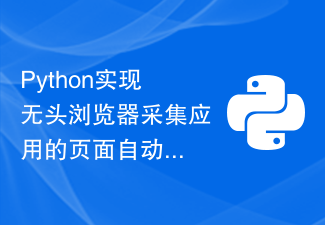 Python实现无头浏览器采集应用的页面自动刷新与定时任务功能解析Aug 08, 2023 am 08:13 AM
Python实现无头浏览器采集应用的页面自动刷新与定时任务功能解析Aug 08, 2023 am 08:13 AMPython实现无头浏览器采集应用的页面自动刷新与定时任务功能解析随着网络的快速发展和应用的普及,网页数据的采集变得越来越重要。而无头浏览器则是采集网页数据的有效工具之一。本文将介绍如何使用Python实现无头浏览器的页面自动刷新和定时任务功能。无头浏览器采用的是无图形界面的浏览器操作模式,能够以自动化的方式模拟人类的操作行为,从而实现访问网页、点击按钮、填
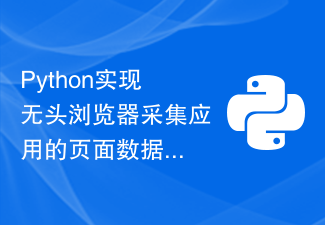 Python实现无头浏览器采集应用的页面数据缓存与增量更新功能剖析Aug 08, 2023 am 08:28 AM
Python实现无头浏览器采集应用的页面数据缓存与增量更新功能剖析Aug 08, 2023 am 08:28 AMPython实现无头浏览器采集应用的页面数据缓存与增量更新功能剖析导语:随着网络应用的不断普及,许多数据采集任务需要对网页进行抓取和解析。而无头浏览器通过模拟浏览器的行为,可以实现对网页的完全操作,使得页面数据的采集变得简单高效。本文将介绍使用Python实现无头浏览器采集应用的页面数据缓存与增量更新功能的具体实现方法,并附上详细的代码示例。一、基本原理无头
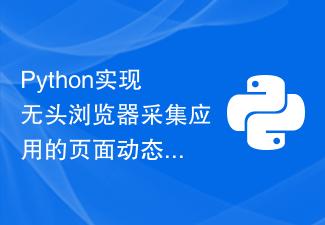 Python实现无头浏览器采集应用的页面动态加载与异步请求处理功能解析Aug 08, 2023 am 10:16 AM
Python实现无头浏览器采集应用的页面动态加载与异步请求处理功能解析Aug 08, 2023 am 10:16 AMPython实现无头浏览器采集应用的页面动态加载与异步请求处理功能解析在网络爬虫中,有时候需要采集使用了动态加载或者异步请求的页面内容。传统的爬虫工具对于这类页面的处理存在一定的局限性,无法准确获取到页面上通过JavaScript生成的内容。而使用无头浏览器则可以解决这个问题。本文将介绍如何使用Python实现无头浏览器来采集使用动态加载与异步请求的页面内容
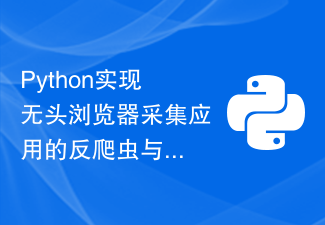 Python实现无头浏览器采集应用的反爬虫与反检测功能解析与应对策略Aug 08, 2023 am 08:48 AM
Python实现无头浏览器采集应用的反爬虫与反检测功能解析与应对策略Aug 08, 2023 am 08:48 AMPython实现无头浏览器采集应用的反爬虫与反检测功能解析与应对策略随着网络数据的快速增长,爬虫技术在数据采集、信息分析和业务发展中扮演着重要的角色。然而,随之而来的反爬虫技术也在不断升级,给爬虫应用的开发和维护带来了挑战。为了应对反爬虫的限制和检测,无头浏览器成为了一种常用的解决方案。本文将介绍Python实现无头浏览器采集应用的反爬虫与反检测功能的解析与
 Python实现无头浏览器采集应用的页面内容解析与结构化功能详解Aug 09, 2023 am 09:42 AM
Python实现无头浏览器采集应用的页面内容解析与结构化功能详解Aug 09, 2023 am 09:42 AMPython实现无头浏览器采集应用的页面内容解析与结构化功能详解引言:在当今信息爆炸的时代,网络上的数据量庞大且杂乱无章。如今很多应用都需要从互联网上采集数据,但是传统的网络爬虫技术往往需要模拟浏览器行为来获取需要的数据,而这种方式在很多情况下并不可行。因此,无头浏览器成为了一种很好的解决方案。本文将详细介绍如何使用Python实现无头浏览器采集应用的页面内
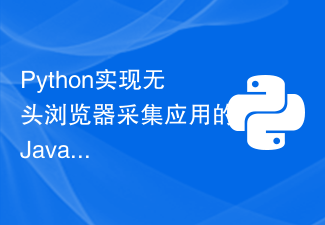 Python实现无头浏览器采集应用的JavaScript渲染与页面动态加载功能解析Aug 09, 2023 am 08:03 AM
Python实现无头浏览器采集应用的JavaScript渲染与页面动态加载功能解析Aug 09, 2023 am 08:03 AM标题:Python实现无头浏览器采集应用的JavaScript渲染与页面动态加载功能解析正文:随着现代Web应用的流行,越来越多的网站采用了JavaScript来实现动态加载内容和数据渲染。这对于爬虫来说是一个挑战,因为传统的爬虫无法解析JavaScript。为了处理这种情况,我们可以使用无头浏览器,通过模拟真实浏览器行为来解析JavaScript并获取动态
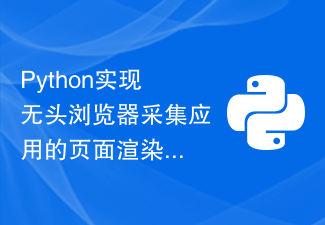 Python实现无头浏览器采集应用的页面渲染与截取功能剖析Aug 11, 2023 am 09:24 AM
Python实现无头浏览器采集应用的页面渲染与截取功能剖析Aug 11, 2023 am 09:24 AMPython实现无头浏览器采集应用的页面渲染与截取功能剖析摘要:无头浏览器是一种无界面的浏览器,可以模拟用户操作,实现页面渲染与截取功能。本文将深入剖析Python中如何实现无头浏览器的应用。一、什么是无头浏览器无头浏览器是一种无需图形用户界面即可运行的浏览器工具。与传统的浏览器不同,无头浏览器不会将网页内容可视化展示给用户,而是直接将页面渲染后的结果返回给
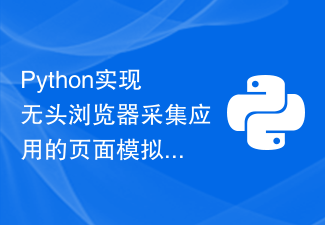 Python实现无头浏览器采集应用的页面模拟点击与滚动功能解析Aug 09, 2023 pm 05:13 PM
Python实现无头浏览器采集应用的页面模拟点击与滚动功能解析Aug 09, 2023 pm 05:13 PMPython实现无头浏览器采集应用的页面模拟点击与滚动功能解析在进行网络数据采集时,经常会遇到需要模拟用户操作,如点击按钮、下拉滚动等情况。而实现这些操作的一种常见方法就是使用无头浏览器。无头浏览器实际上是一种没有用户界面的浏览器,通过编程的方式来模拟用户操作。而Python语言提供了很多库来实现无头浏览器的操作,其中最常用的是selenium库。selen


Hot AI Tools

Undresser.AI Undress
AI-powered app for creating realistic nude photos

AI Clothes Remover
Online AI tool for removing clothes from photos.

Undress AI Tool
Undress images for free

Clothoff.io
AI clothes remover

AI Hentai Generator
Generate AI Hentai for free.

Hot Article

Hot Tools

SublimeText3 Mac version
God-level code editing software (SublimeText3)

SAP NetWeaver Server Adapter for Eclipse
Integrate Eclipse with SAP NetWeaver application server.

Atom editor mac version download
The most popular open source editor

mPDF
mPDF is a PHP library that can generate PDF files from UTF-8 encoded HTML. The original author, Ian Back, wrote mPDF to output PDF files "on the fly" from his website and handle different languages. It is slower than original scripts like HTML2FPDF and produces larger files when using Unicode fonts, but supports CSS styles etc. and has a lot of enhancements. Supports almost all languages, including RTL (Arabic and Hebrew) and CJK (Chinese, Japanese and Korean). Supports nested block-level elements (such as P, DIV),

SecLists
SecLists is the ultimate security tester's companion. It is a collection of various types of lists that are frequently used during security assessments, all in one place. SecLists helps make security testing more efficient and productive by conveniently providing all the lists a security tester might need. List types include usernames, passwords, URLs, fuzzing payloads, sensitive data patterns, web shells, and more. The tester can simply pull this repository onto a new test machine and he will have access to every type of list he needs.





